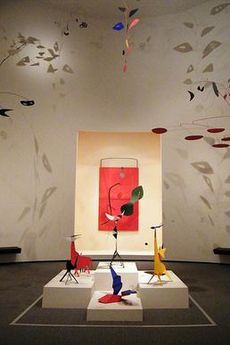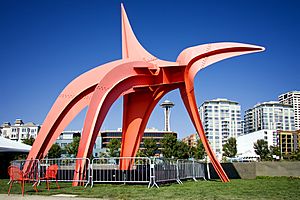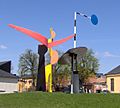Alexander Calder facts for kids
Quick facts for kids
Alexander Calder
|
|
|---|---|
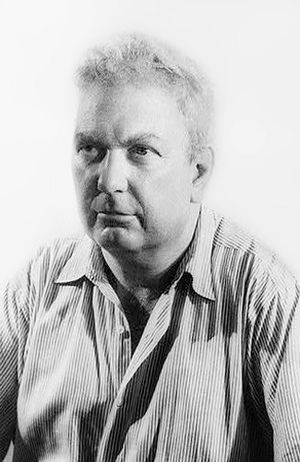
Alexander Calder, by Carl Van Vechten, 1947
|
|
| Born | July 22, 1898 |
| Died | November 11, 1976 (aged 78) New York City, New York, US
|
| Nationality | American |
| Alma mater | Stevens Institute of Technology, Art Students League of New York |
| Known for | Sculpture |
| Movement | Kinetic art, Surrealism, Abstraction (art) |
Alexander Calder (born July 22, 1898 – died November 11, 1976) was an American sculptor. He is famous for his amazing "mobiles," which are sculptures that move. These mobiles can be powered by motors or even just air currents. He also made "stabiles," which are sculptures that stand still, and huge public artworks. Calder didn't like to overthink his art. He once said that theories are good for the artist, but they shouldn't be shared with everyone else.
Contents
Who Was Alexander Calder?
Alexander Calder, often called "Sandy," was born in 1898 in Lawnton, Pennsylvania. His family was full of artists! His grandfather, Alexander Milne Calder, was a sculptor known for the giant statue of William Penn in Philadelphia. His father, Alexander Stirling Calder, was also a famous sculptor who made many public artworks. Calder's mother, Nanette, was a professional portrait artist. She studied art in Paris.
Calder's Early Years and First Creations
From a very young age, Calder loved to create. When he was just four, he posed for his father's sculpture called The Man Cub. In 1902, he made his first sculpture, a clay elephant.
His family moved around a lot, from Arizona to California and New York. No matter where they lived, Calder's parents always made sure he had a special place, like a cellar, to use as his art studio. This is where he got his first tools. He used copper wire scraps to make jewelry for his sister's dolls.
One Christmas, he made a dog and a duck out of sheet brass for his parents. The duck sculpture could even rock when you gently tapped it, showing his early interest in movement. He also built a cool system of mechanical trains with a friend, powered by gravity!
Calder graduated from Lowell High School in San Francisco in 1915.
Becoming an Artist
Calder's parents didn't want him to be an artist. So, he decided to study mechanical engineering at the Stevens Institute of Technology in New Jersey, starting in 1915. He was good at math and well-liked by his classmates.
After graduating in 1919, Calder worked several different jobs, including as an engineer and a draughtsman. In 1922, while working on a ship, he saw a beautiful sunrise and a full moon at the same time off the coast of Guatemala. This moment inspired him to become an artist.
Moving to New York and Paris
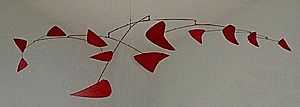
Calder moved back to New York City and enrolled at the Art Students League of New York. He also worked for the National Police Gazette newspaper. In 1925, he sketched the Ringling Bros. and Barnum & Bailey Circus. He loved the circus so much that it became a big theme in his later art.
In 1926, Calder moved to Paris, France, which was a hub for artists. He met his future wife, Louisa James, in 1929. They married in 1931 and later moved to a farmhouse in Connecticut, where they raised their two daughters. In Paris, Calder became friends with many famous artists like Fernand Léger and Marcel Duchamp.
He also had a workshop in France later in his life and often gave his artworks French names. Calder passed away in 1976, shortly after a big art show of his work in New York.
Calder's Amazing Artworks
The Cirque Calder and Wire Sculptures
In Paris, Calder started creating his Cirque Calder (Calder Circus). This was a miniature circus made from wire, cloth, string, and other everyday items. He could pack it into five suitcases and perform it for people! It became very popular with other artists in Paris.
He also invented wire sculpture, which he called "drawing in space." He had his first art show of these wire sculptures in Paris in 1929.
Mobiles and Stabiles: Art That Moves!
In 1930, Calder visited the studio of artist Piet Mondrian. This visit really inspired him to create abstract art, which uses shapes and colors instead of realistic images.
This led him to make his first truly moving sculptures, powered by motors. His friend, artist Marcel Duchamp, called these "mobiles." This was a clever French word meaning both "motion" and "motive." Calder realized that motor-powered movements could be boring. So, by 1932, he started making hanging sculptures that moved with just a touch or air currents. These "wind mobiles" had abstract shapes balanced on rods, creating a beautiful, ever-changing dance of forms.
Around the same time, he also started making sculptures that stood still. Another artist, Jean Arp, called these "stabiles" to show they were different from the moving mobiles.
During World War II, aluminum was hard to get, so Calder started carving wood. He made new open sculptures called "constellations." After the war, he went back to cutting shapes from sheet metal and painting them in bright colors.
Giant Public Sculptures
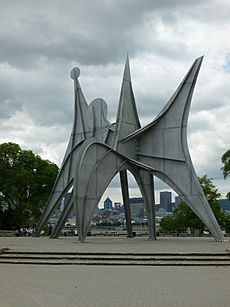
In the 1950s and 1960s, Calder started making huge sculptures, called "monumental sculptures," for public places. He would first make a small model, then it would be scaled up to a giant size by engineers and technicians.
Some famous examples include:
- .125 (1957) at John F. Kennedy International Airport in New York.
- Spirale (1958) for UNESCO in Paris.
- Trois disques (1967) for Expo 67 in Montreal, Canada.
- El Sol Rojo (1968), his largest sculpture at 25.7 meters high, built for the 1968 Summer Olympics in Mexico City.
- La Grande Vitesse (1969) in Grand Rapids, Michigan, which was the first public sculpture in the U.S. to get funding from the National Endowment for the Arts.
- Bent Propeller (1971) at the World Trade Center in New York City (sadly, it was destroyed on September 11, 2001).
- Flamingo (1974) in Chicago.
Most of his large sculptures were made in France. He would oversee the process to make sure they looked just right.
Art for the Stage, Paper, and Even Airplanes!
Calder also designed stage sets for many plays and ballets. He even created his own "ballet" called Works in Progress in 1968, which featured his mobiles and stabiles moving on stage.
Besides sculptures, Calder painted and made prints throughout his life. His prints also became abstract, using lines to show geometric shapes in motion. He even used prints to protest the Vietnam War.
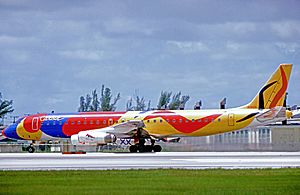
One very unusual project was when an airline, Braniff International Airways, asked him to paint a full-size Douglas DC-8 jet! He called it Flying Colors. Later, he designed another plane for the U.S. Bicentennial, called the Flying Colors of the United States, which looked like a waving American flag.
In 1975, he also painted a BMW 3.0 CSL car, which was the first car in the famous BMW Art Car Project.
Unique Jewelry Creations
Calder made over 2,000 pieces of jewelry, often as gifts for his friends. He mostly used brass and steel, sometimes adding bits of ceramic, wood, or glass. He rarely used solder; instead, he linked metal strips with loops or wire. He even made his first jewelry at age eight for his sister's dolls!
He made a brass ring for his friend Joan Miró and huge silver mobile earrings for Peggy Guggenheim. Many famous artists and writers received his unique jewelry.
Art Shows and Collections
Calder had his first solo art show in Paris in 1927. His first museum show in the U.S. was in Chicago in 1935. The Museum of Modern Art in New York was a big supporter of his work. In 1943, they held a huge show of his art that was so popular it had to be extended!
His art is now in many museums around the world, including the Whitney Museum of American Art in New York (which has the largest collection), the Museum of Modern Art, and the National Gallery of Art in Washington, D.C.
In Philadelphia, you can see art by three generations of Alexander Calders! From the Philadelphia Museum of Art, you can see a mobile by the youngest Alexander Calder, a fountain by his father, and the statue of William Penn by his grandfather on City Hall.
Awards and Honors
Calder received many awards for his art throughout his life.
- In 1952, he won the main prize for sculpture at the Venice Biennale, representing the United States.
- He received the Gold Medal of Honor for sculpture at UNESCO in 1960.
- In 1968, he was honored by the Ministry of Culture in France.
- He received the Gold Medal for Sculpture from the National Institute of Arts and Letters in 1971.
- After he passed away, he was given the Presidential Medal of Freedom, the highest civilian honor in the United States, by President Gerald Ford.
Art Market and Value
In the early days, Calder's art didn't sell for much. The Museum of Modern Art bought its first Calder in 1934 for only $60! But by 1948, his art was selling out shows, and he became a famous international sculptor.
Today, his artworks are very valuable. In 2012, a standing mobile called Lily of Force sold for $18.5 million. In 2014, a hanging mobile called Poisson volant (Flying Fish) sold for $25.9 million, setting a new record for his sculptures at auction.
Calder's Legacy
Since 1966, the winners of the National Magazine Awards receive a special trophy called an "Ellie," which is a copper-colored stabile designed by Calder.
The Calder Foundation
In 1987, Calder's family created the Calder Foundation. This foundation works to collect, show, and protect Alexander Calder's art and his historical records. They have a huge collection of his works, including over 600 sculptures and thousands of paintings, drawings, toys, and jewelry pieces.
Calder's grandson, Alexander S. C. "Sandy" Rower, is the president of the foundation. The foundation helps organize art shows of Calder's work all over the world.
Calder's Family Life
Alexander Calder and his wife, Louisa, had two daughters, Sandra and Mary. Many of his grandchildren and great-grandchildren have also been involved with art and the Calder Foundation. His daughter Sandra is even an illustrator of children's books. The Calder family has a special connection with The Putney School in Vermont, where many family members have attended.
Selected Works
- Dog (1909), a brass sculpture made for his parents.
- Elephant (c. 1928), made of wire and wood.
- Hi! (ca. 1928), a wire sculpture.
- Aztec Josephine Baker (1930), a wire sculpture of the famous dancer.
- Untitled (1931), one of his first kinetic (moving) mobiles.
- Small Feathers (1931), an early true mobile.
- Mercury Fountain (1937), a unique sculpture with liquid mercury.
- Lobster Trap and Fish Tail (1939), a suspended mobile for the Museum of Modern Art.
- Black Beast (1940), a freestanding stabile.
- S-Shaped Vine (1946), a suspended mobile.
- Snow Flurry (1948), a suspended mobile.
- .125 (1957), a steel sculpture at JFK Airport.
- Teodelapio (1962), a monumental stabile in Italy.
- La Grande voile (1966), a 33-ton metal sculpture at MIT.
- Trois disques (1967), a huge stainless steel stabile in Montreal.
- La Grande Vitesse (1969), a famous stabile in Grand Rapids, Michigan.
- Bent Propeller (1970–71), a sculpture at the World Trade Center (destroyed 2001).
- Eagle (1971), a large steel sculpture in Seattle.
- Flamingo (1974), a red steel sculpture in Chicago.
- Universe (1974), a motorized "wallmobile" at the Willis Tower in Chicago.
- Flying Dragon (1975), a red steel stabile in Chicago.
- L'Araignée Rouge (The Red Spider) (1976), a 15m tall sculpture in Paris.
- Mountains and Clouds (1976), a large sculpture in Washington, D.C.
Images for kids
-
Acoustic Ceiling (1953), Aula Magna, Universidad Central de Venezuela, Caracas, Venezuela
-
De tre vingarna (The Three Wings) (1967), Blå Stället, Angered, Gothenburg, Sweden.
-
Three Disks, One Lacking (1968), Franklin Parkway, Philadelphia, Pennsylvania
-
Bobine (Bobbin) (1970), National Gallery of Australia, Canberra, Australia
-
Le hallebardier (The Halberdier) (1971), Sprengel Museum, Hanover, Germany
-
Crinkly avec disque rouge (Crinkly with Red Disk) (1973), Schlossplatz in Stuttgart, Germany
-
Feuille d'arbre (Tree leaf) (1974), Tel Aviv, Israel
-
Flying Dragon (1975), Art Institute of Chicago
See also
 In Spanish: Alexander Calder para niños
In Spanish: Alexander Calder para niños




